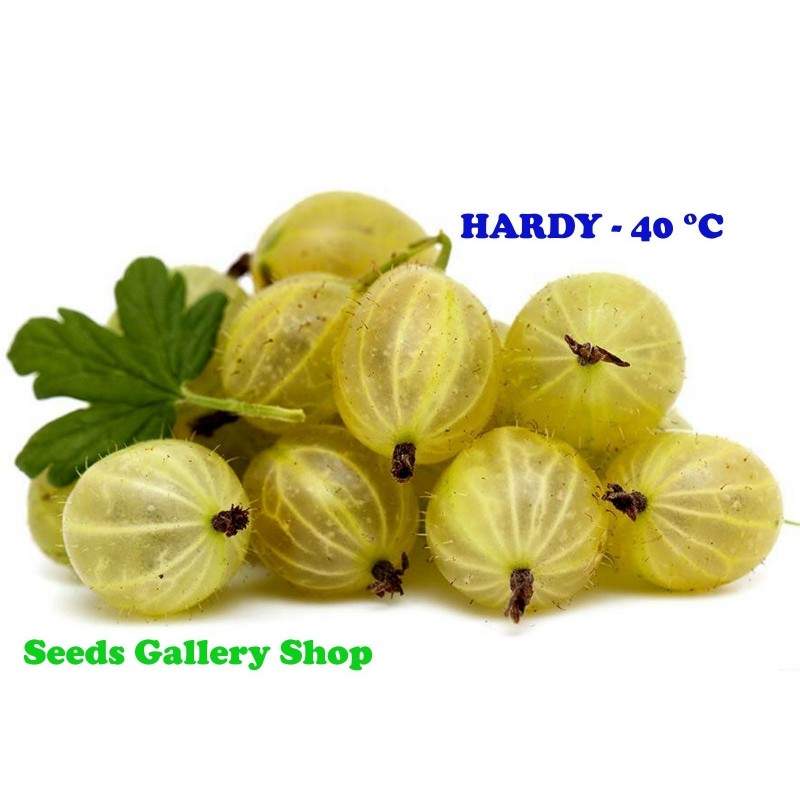






Ribes uva-crispa is a deciduous Shrub growing to 1.2 m (4ft) by 1 m (3ft 3in) at a medium rate. It is hardy and is frost tender. It is in flower from Mar to May, and the seeds ripen from Jul to September.
Ribes uva-crispa is a deciduous Shrub growing to 1.2 m (4ft) by 1 m (3ft 3in) at a medium rate.
It is hardy and is frost tender. It is in flower from Mar to May, and the seeds ripen from Jul to September. The flowers are hermaphrodite (have both male and female organs) and are pollinated by Insects.The plant is self-fertile.
Suitable for: light (sandy), medium (loamy) and heavy (clay) soils and prefers well-drained soil. Suitable pH: acid, neutral and basic (alkaline) soils. It can grow in semi-shade (light woodland) or no shade. It prefers moist soil.
Edible Uses:
Fruit - raw or cooked[1, 2, 5, 7, 61]. The fruit is often picked when under-ripe and very firm, it has a very tart flavour at this time and is mainly used in making pies, jams etc. However, if the fruit is allowed to remain on the plant until it is fully ripe and soft it becomes quite sweet and is delicious for eating out of hand[K]. The fruit of the wild species is often less than 1cm in diameter, but named cultivars have considerably larger fruits up to 3cm in diameter[K]. Leaves- raw. The young and tender leaves can be eaten in salads[4]. Some caution is advised, see the notes above on toxicity.
Medicinal Uses
Plants For A Future can not take any responsibility for any adverse effects from the use of plants. Always seek advice from a professional before using a plant medicinally.
Astringent; Laxative; Miscellany.
The fruit is laxative. Stewed unripe gooseberries are used as a spring tonic to cleanse the system. The leaves have been used in the treatment of gravel. An infusion taken before the monthly periods is said to be a useful tonic for growing girls. The leaves contain tannin and have been used as an astringent to treat dysentery and wounds.
Cultivation details
Easily grown in a moisture retentive but well-drained loamy soil of at least moderate quality. Growth is often poor in light soils, whilst heavy soils encourage soft growth and excess vigour. Prefers a pH in the range 6 to 6.5, though it can grow well in more acid or alkaline soils. It is important to add plenty of humus to chalky soil. Plants are quite tolerant of shade though do not fruit so well in such a position. They can be grown against east or north facing walls. The fruit of plants on north facing walls will ripen later, thus extending the fruiting season, though yields will be lower. Plants dislike very hot weather. Dormant plants are hardy to about -20°c, but the flowers and young fruits are susceptible to frost damage Plants are very susceptible to potash deficiency, especially when grown on alkaline soils. Gooseberries are commonly cultivated in temperate regions for their edible fruit, there are many named varieties.
Birds love the fruit and so some protection is often required, especially if the fruit is being grown to full ripeness. Plants grow best in cool moist climates such as N. Europe. Plants fruit best on one and two year old wood so any pruning should be to encourage vigorous new shoots. Plants can harbour a stage of white pine blister rust, so should not be grown in the vicinity of pine trees. Plants in this genus are notably susceptible to honey fungus.
Propagation
Seed - best sown as soon as it is ripe in the autumn in a cold frame. Stored seed requires 3 months cold stratification at between 0 and 5°c and should be sown as early in the year as possible. Under normal storage conditions the seed can remain viable for 17 years or more.
Prick out the seedlings into individual pots when they are large enough to handle and grow them on in a cold frame for their first winter, planting them out in late spring of the following year. Cuttings of half-ripe wood, 10 - 15cm with a heel, July/August in a frame.
Cuttings of mature wood of the current year's growth, preferably with a heel of the previous year's growth, November to February in a cold frame or sheltered bed outdoors.
Bilgi kartı
 Reviews (0)
Reviews (0)